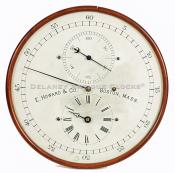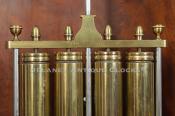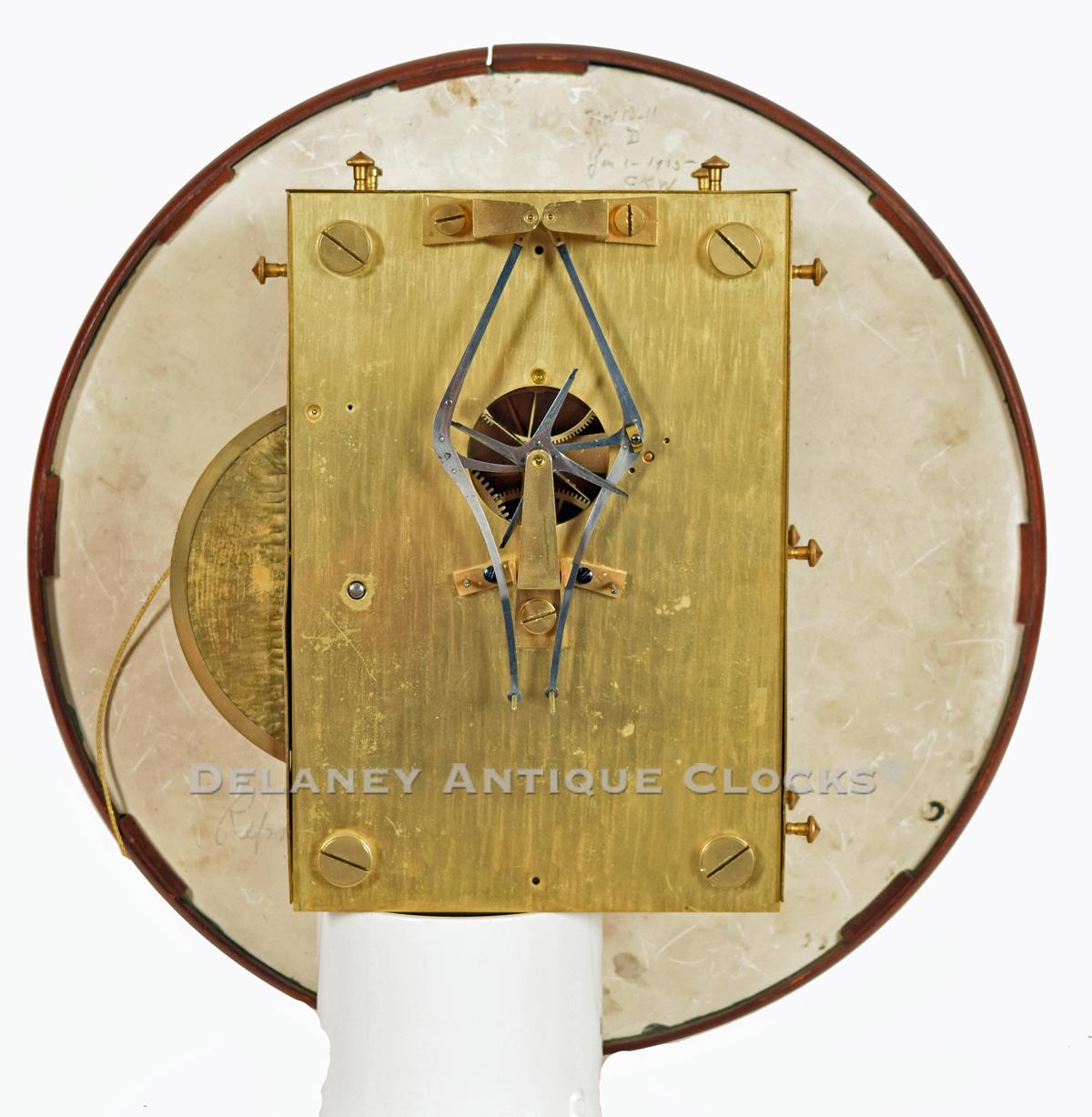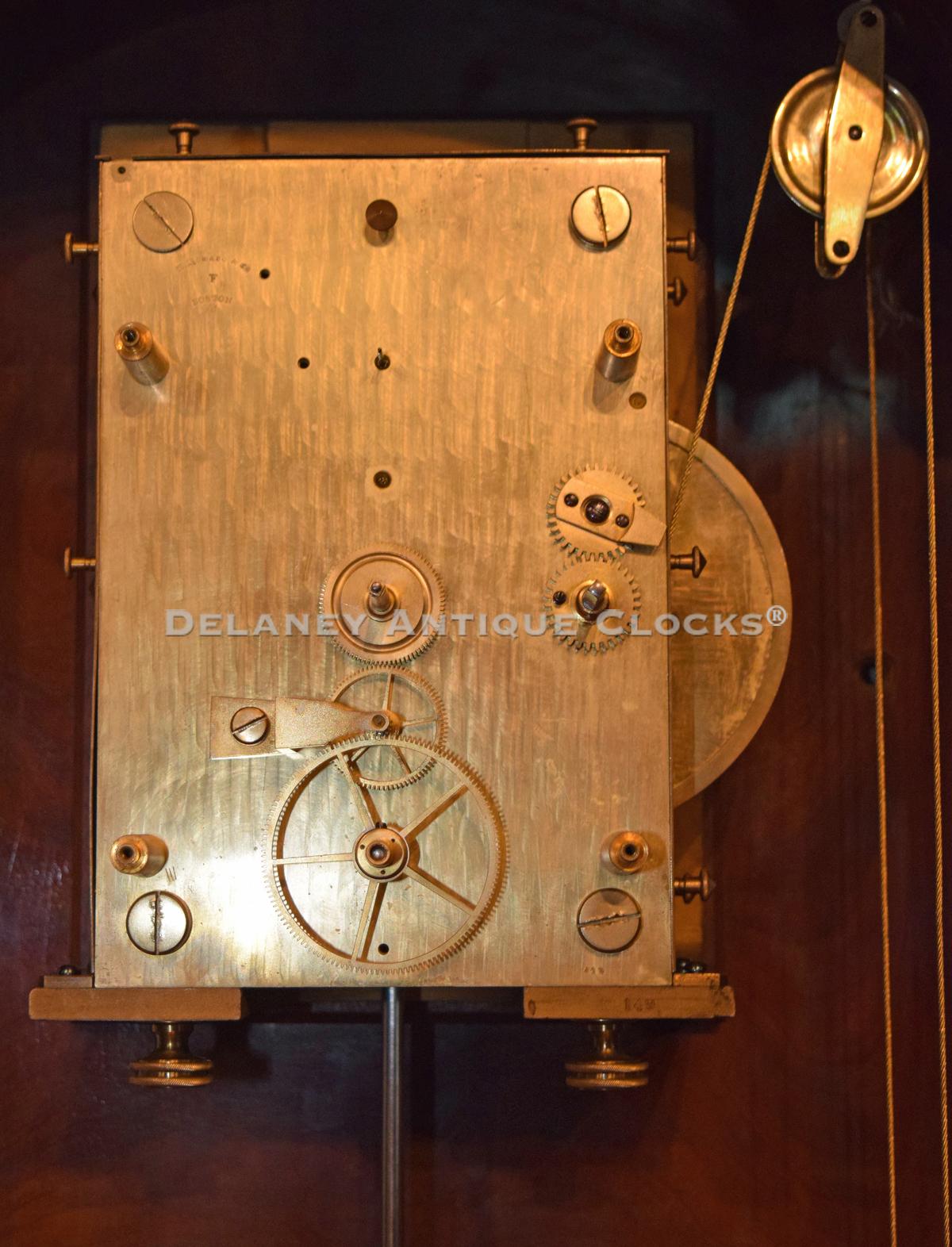E. Howard & Co., of Boston, MA. Model No. 61 Floor Standing Regulator Clock with Dennison's gravity escapement. The Western Electrical Company ordered this fine regulator for the Metropolitan Life Insurance Company in New York City. 222056.
This is an outstanding regulator and may be the best Model 61 known. It was made by the E. Howard & Company of Boston, Massachusetts. Like most big Howard regulators, this is not an easy model to locate. As a general rule, very few large Howard clocks come onto the public marketplace in any given year. In the late 1880s, the E. Howard Model No. 5 banjo sold for $20. In comparison, the entry model 61 regulator would have sold for approximately $200. The example discussed here is a special example having the highest grade astronomical regulator movement that featured Dennison's gravity escapement. It was also specially ordered with a gilded four-jar compensating pendulum bob and minute contacts. As a result, The Howard Clock Company charged The Western Electric Company of New York City $377.50 for this clock which was ordered on December 2, 1892, and completed on February 11, 1893.
One of the first aspects that most people comment on when viewing an astronomical regulator is the format of the time displayed on the dial. When the hours, minutes, and seconds are displayed individually, the dial is described as an astronomical dial. Clocks that feature this display are considered somewhat rare. This glass dial measures 15 inches (14-inch sight size) in diameter. The graphics are painted from the back and are original to this clock. The presentation features an outside chapter ring for the minutes, including Arabic five-minute markers and individual minute marks. The subsidiary hour dial has bold black Roman-style hour numerals, and the subsidiary seconds dial has ten-second Arabic markers. Across the middle of this dial is the manufacturer's name, "E. Howard & Co. - Boston, Mass." Each of the individual dials has its original blued, cut steel hand to display the appropriate information.
This heavily constructed brass mechanism measures approximately 9.5 inches tall, 6.5 inches wide, and 2.25 inches deep. A large cast iron mounting bracket supports it. Both heavy rectangular-shaped plates retain their original decorative scraping design. The front plate is die-stamped "E. Howard & Co. / F / Boston" in the upper left-hand corner. The number "149" is stamped down on the lower right. This number is also stamped on the front of the mounting bracket. If you look at the top of the front plate, you will find the number "3" stamped there. This number is also on the dust cover, which encloses the fine-quality gearing. The dust covers are secured to the sides of the plates with multiple thumbscrews. The movement is weight-powered. The weight is directed with pulleys to travel up and down the right side of the works. Hardened steel shafts support the finely manufactured gearing. The escapement is rare and extremely desirable. This Denison-designed gravity escapement features two gravity arms and four legs. The gravity arms are steel and they provide the impulse to the free-swinging pendulum. The contact point on the arms is fitted with a roller. The stops on the gravity arms are jeweled. The benefit of this escapement is that the pendulum is not powered by the crutch and escape wheel. This was an important advancement in a clock's ability to keep precision time. Maintaining power is fitted to the main wheel. The mechanism is wound with a crank key and protected with a full Geneva Stop winding mechanism. This movement was also ordered with an electrical minute contact to drive 26 electrical dial clocks, which would have been positioned in various locations in the original building. Unfortunately, the contacts are now gone, but the brass fittings or terminals are still fitted on the top of the case.
The brass and steel compensating pendulum is fitted with four special jars. They are metal, secured closed with treaded tops, and prepared to be gilded. This was specified in the original order. As a result, they are not nickel plated as one would expect. The gilding has since been lost, leaving the tubes in a gold finish. The four individual cansisters are filled with a measured amout of mercury, which is used to compensate for temperature changes. The pendulum's upper frame is numbered "408" and "321." These numbers coincide with the original order in the Howard records. The steel rods are stamped with the number "11." This pendulum is original to this clock. The pendulum hangs from the mounting bracket that is secured to the back of the case. This bracket serves double duty as it supports the movement as well. The suspension blocks are stamped with the number 4. The pendulum bob swings in front of engraved brass and silvered beat scale. The supporting bracket is wonderfully hand carved. It is mounted to the bottom of the case.
Model Number 61 sold well. This example is housed in a mahogany case. The woodwork retains what appears to be an original surface. The design features carved embellishments in the Victorian style. The case dimensions are as follows: 93.5 inches tall, 30.5 inches wide, and 13 inches deep.
Inventory number 222056.
To my knowledge, only three Model 61 clocks were ordered with a gravity escapement. This is the best of the group.
The E. Howard & Company succeeded the Howard & Davis firm in 1857. The Howard & Davis firm was comprised of Edward Howard and David Porter Davis and was established in 1842 in Roxbury, Massachusetts. Both men had just completed their clock apprenticeship under the guidance of Aaron Willard Jr in Boston. The Howard & Davis firm made high-grade clocks, precision balances, sewing machines, fire engines, and watches. After the dissolution of Howard & Davis, Edward Howard became Boston's leading manufacturer of weight-driven residential and commercial clocks. The firm also made a large number of tower clocks and watchman and salve clock systems. These sold well in the last quarter of the 1800s.
It has been said that the E. Howard Clock company never made an inexpensive clock, and everything they made was of very good quality. As a result, Howard clocks have become very collectible and are prized by their owners. Today, the E. Howard name enjoys outstanding name recognition.
For a more in-depth reading of Edward Howard and his various businesses, please read "Willard's Patent Time Pieces," written by Paul Foley.




















